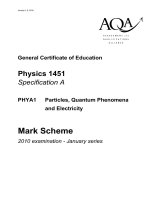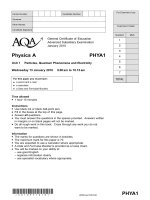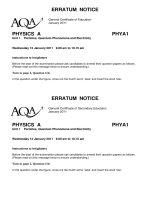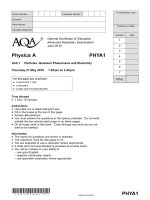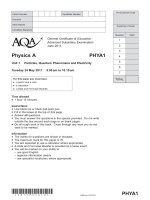- Trang chủ >>
- Khoa Học Tự Nhiên >>
- Vật lý
Vật lý A level:AQA PHYA1 w MS JAN12
Bạn đang xem bản rút gọn của tài liệu. Xem và tải ngay bản đầy đủ của tài liệu tại đây (217.9 KB, 8 trang )
Version 1.0
General Certificate of Education (A-level)
January 2012
Physics A
(Specification 2450)
PHYA1
Unit 1: Particles, quantum phenomena and
electricity
Final
Mark Scheme
Mark schemes are prepared by the Principal Examiner and considered, together with the
relevant questions, by a panel of subject teachers. This mark scheme includes any
amendments made at the standardisation events which all examiners participate in and is the
scheme which was used by them in this examination. The standardisation process ensures
that the mark scheme covers the students’ responses to questions and that every examiner
understands and applies it in the same correct way. As preparation for standardisation each
examiner analyses a number of students’ scripts: alternative answers not already covered by
the mark scheme are discussed and legislated for. If, after the standardisation process,
examiners encounter unusual answers which have not been raised they are required to refer
these to the Principal Examiner.
It must be stressed that a mark scheme is a working document, in many cases further
developed and expanded on the basis of students’ reactions to a particular paper.
Assumptions about future mark schemes on the basis of one year’s document should be
avoided; whilst the guiding principles of assessment remain constant, details will change,
depending on the content of a particular examination paper.
Further copies of this Mark Scheme are available from: aqa.org.uk
Copyright © 2012 AQA and its licensors. All rights reserved.
Copyright
AQA retains the copyright on all its publications. However, registered schools/colleges for AQA are permitted to copy material
from this booklet for their own internal use, with the following important exception: AQA cannot give permission to
schools/colleges to photocopy any material that is acknowledged to a third party even for internal use within the centre.
Set and published by the Assessment and Qualifications Alliance.
The Assessment and Qualifications Alliance (AQA) is a company limited by guarantee registered in England and Wales (company number 3644723) and a registered
charity (registered charity number 1073334).
Registered address: AQA, Devas Street, Manchester M15 6EX.
Mark Scheme – General Certificate of Education (A-level) Physics A – PHYA1 – January 2012
3
Instructions to Examiners
1 Give due credit for alternative treatments which are correct. Give marks for what is correct in
accordance with the mark scheme; do not deduct marks because the attempt falls short of
some ideal answer. Where marks are to be deducted for particular errors, specific instructions
are given in the marking scheme.
2 Do not deduct marks for poor written communication. Refer the scripts to the Awards meeting
if poor presentation forbids a proper assessment. In each paper, candidates are assessed on
their quality of written communication (QWC) in designated questions (or part-questions) that
require explanations or descriptions. The criteria for the award of marks on each such
question are set out in the mark scheme in three bands in the following format. The descriptor
for each band sets out the expected level of the quality of written communication of physics for
each band. Such quality covers the scope (eg relevance, correctness), sequence and
presentation of the answer. Amplification of the level of physics expected in a good answer is
set out in the last row of the table. To arrive at the mark for a candidate, their work should first
be assessed holistically (ie in terms of scope, sequence and presentation) to determine which
band is appropriate then in terms of the degree to which the candidate’s work meets the
expected level for the band.
QWC descriptor mark range
Good - Excellent
see specific mark scheme 5-6
Modest - Adequate
see specific mark scheme 3-4
Poor - Limited
see specific mark scheme 1-2
The description and/or explanation expected in a good answer should include a
coherent account of the following points:
see specific mark scheme
Answers given as bullet points should be considered in the above terms. Such answers
without an ‘overview’ paragraph in the answer would be unlikely to score in the top band.
3 An arithmetical error in an answer will cause the candidate to lose one mark and should be
annotated AE if possible. The candidate’s incorrect value should be carried through all
subsequent calculations for the question and, if there are no subsequent errors, the candidate
can score all remaining marks.
4 The use of significant figures is tested once on each paper in a designated question or part-
question. The numerical answer on the designated question should be given to the same
number of significant figures as there are in the data given in the question or to one more than
this number. All other numerical answers should not be considered in terms of significant
figures.
5 Numerical answers presented in non-standard form are undesirable but should not be
penalised. Arithmetical errors by candidates resulting from use of non-standard form in a
candidate’s working should be penalised as in point 3 above. Incorrect numerical prefixes and
the use of a given diameter in a geometrical formula as the radius should be treated as
arithmetical errors.
6 Knowledge of units is tested on designated questions or parts of questions in each a paper.
On each such question or part-question, unless otherwise stated in the mark scheme, the
mark scheme will show a mark to be awarded for the numerical value of the answer and a
further mark for the correct unit. No penalties are imposed for incorrect or omitted units at
intermediate stages in a calculation or at the final stage of a non-designated ‘unit’ question.
7 All other procedures including recording of marks and dealing with missing parts of answers
will be clarified in the standardising procedures.
Mark Scheme – General Certificate of Education (A-level) Physics A – PHYA1 – January 2012
4
GCE Physics, Specification A, PHYA1, Particles, Quantum Phenomena and Electricity
Question 1
a
7
particle
quark
structure
charge strangeness
baryon
number
proton uud + 1 0 1
sigma
+
uus + 1 – 1 1
π
+
ud
�
+ 1 0 0
b i examples:
proton, antiquarks
1
b ii consists of 3 antiquarks
1
b iii same (rest) mass (energy)
2
difference eg baryon number/charge
Total 11
Question 2
a the ratio of charge to mass of nucleus
2
C kg
–1
b i
number of protons and neutrons the same or number of neutrons less or
mass the same
2
but more protons therefore greater charge
b ii answers add up to 10
4
number of protons = 4
number of neutrons = 10 – 4 = 6
evidence of correct calculation
eg 5q = 1.25 × ?q
? = 4
Total 8
Mark Scheme – General Certificate of Education (A-level) Physics A – PHYA1 – January 2012
5
Question 3
a photon interacts with (orbital) electron/nucleus/atom
max 2
energy of photon used to create particle antiparticle pair
to conserve momentum photon needs to interact with interacting particle
b energy of photon depends on frequency
3
if energy/frequency is below a certain value there is not enough energy
to provide mass/rest energy of particles
c any two
2
eg charge
lepton number
baryon number
strangeness
Total 7
Question 4
a i
when electrons/atoms are in their lowest/minimum energy (state) or most
stable (state) they (are in their ground state)
1
a ii in either case an electron receives (exactly the right amount of) energy
3
excitation promotes an (orbital) electron to a higher energy/up a level
ionisation occurs (when an electron receives enough energy) to leave the
atom
b electrons occupy discrete energy levels and
max 4
need to absorb an exact amount of/enough energy to move to a higher
level
photons need to have certain frequency to provide this energy or e = hf
energy required is the same for a particular atom or have different energy
levels
all energy of photon absorbed
in 1 to 1 interaction or clear a/the photon and an/the electron
c energy = 13.6 × 1.60 × 10
–19
= 2.176 × 10
–18
(J)
4
hf = 2.176 × 10
–18
f = 2.176 × 10
–18
÷ 6.63 × 10
–34
= 3.28 × 10
15
Hz 3 sfs
Total 12
Mark Scheme – General Certificate of Education (A-level) Physics A – PHYA1 – January 2012
6
Question 5
a i circuit with ammeter and voltmeter correct or ohmmeter
3
some means of heating eg water bath
thermometer in water bath
a ii
The candidate’s writing should be legible and the spelling, punctuation
and grammar should be sufficiently accurate for the meaning to be
clear.
max 6
The candidate’s answer will be assessed holistically. The answer will be
assigned to one of three levels according to the following criteria.
High Level (Good to excellent): 5 or 6 marks
The information conveyed by the answer is clearly organised, logical and
coherent, using appropriate specialist vocabulary correctly. The form and
style of writing is appropriate to answer the question.
The candidate states that resistance is measured using an ohmmeter or
voltmeter ammeter method. The wire is heated in a beaker of water and the
temperature measured with a thermometer. Ice is added to the water and
the water is stirred as the water is heated. Details of how resistance is
calculated and how results are presented e.g. graph of resistivity against
temperature.
Intermediate Level (Modest to adequate): 3 or 4 marks
The information conveyed by the answer may be less well organised and
not fully coherent. There is less use of specialist vocabulary, or specialist
vocabulary may be used incorrectly. The form and style of writing is less
appropriate.
The candidate states that resistance is measured using an ohmmeter or
voltmeter ammeter method. The wire is heated in a beaker of water and the
temperature measured with a thermometer. Ice is added to the water.
Details of how resistance is calculated.
Low Level (Poor to limited): 1 or 2 marks
The information conveyed by the answer is poorly organised and may not
be relevant or coherent. There is little correct use of specialist vocabulary.
The form and style of writing may be only partly appropriate.
The candidate states that resistance is measured using an ohmmeter or
voltmeter ammeter method. The wire is heated in a beaker of water and the
temperature measured with a thermometer.
Mark Scheme – General Certificate of Education (A-level) Physics A – PHYA1 – January 2012
7
The explanation expected in a competent answer should include a
coherent selection of the following points concerning the physical
principles involved and their consequences in this case.
• resistance measured calculated
• water bath used
• ice added to water
• water stirred
• temperature measured with thermometer
• resistance calculated
• graph drawn
b
the temperature at or below which a material
2
becomes a superconductor or has zero resistance/resistivity
Total 11
Question 6
a
(use of P = V/l)
2 l = 36/12 = 3.0 A
l = 2.0/4.5 = 0.44 A
b i pd = 24 – 12 = 12 V
1
b ii current = 3.0 + 0.44 = 3.44 A
1
b iii R
1
= 12/3.44 = 3.5 Ω
1
b iv pd = 12 – 4.5 = 7.5 V
1
b v R
2
= 7.5/0.44 = 17 Ω
1
c i (circuit) resistance increases
2
current is lower (reducing voltmeter reading)
or correct potential divider argument
c ii
pd across Y or current through Y increases
2
hence power/rate of energy dissipation greater or temperature of lamp
increases
Total 11
Mark Scheme – General Certificate of Education (A-level) Physics A – PHYA1 – January 2012
8
Question 7
a i
(use of V = IR)
2
R
total
= 1 (ohm)
V = 1 × 1 = 1.0 V
a ii
(use of V = IR)
2
R = 9.0/1.0 = 9.0 Ω
r = 9.0 – 1.0 – 6.0 = 2.0 Ω
or use of (E = I(R + r))
9.0 = 1(7 + r)
r = 9.0 – 7.0 = 2.0 Ω
a iii
(use of W = Vlt)
2 W = 9.0 × 1.0 × 5 × 60
W = 2700 J
a iv energy dissipated in internal resistance = 1
2
× 2.0 × 5 × 60 = 600 (J)
2
percentage = 100 × 600/2700 = 22% CE from part aii
b internal resistance limits current
max 2
hence can provide higher current
or energy wasted in internal resistance/battery
less energy wasted (with lower internal resistance)
or charges quicker
as current higher or less energy wasted
or (lower internal resistance) means higher terminal pd/voltage
as less pd across internal resistance or mention of lost volts
Total 10
UMS conversion calculator www.aqa.org.uk/umsconversion

